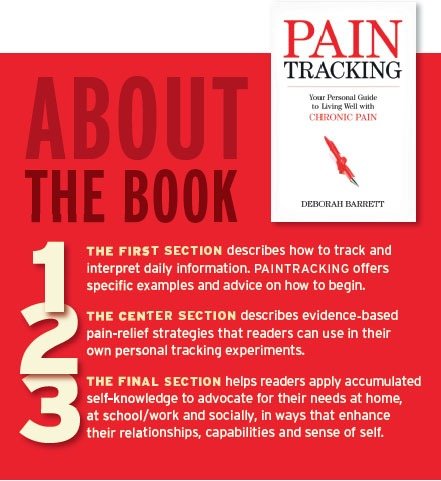What is Paintracking?
Part One of a Four-Part Series by Deborah Barrett, PhD , LCSW
Nearly 20 years ago, when I first developed pain, I assumed I needed rest to heal – but instead, my pain worsened with inactivity, until I could barely hold a paper or open a door. When I read that exercise might help, I joined a gym. During the endorphin high of an intense workout, I felt wonderful. Soon afterward, however, my pain intensified. I would return to bed frustrated, demoralized and stuck in a negative cycle. I felt betrayed by my own body.
Listening to Your Body
We’ve all heard the phrase “listen to your body,” but when it comes to chronic pain, it’s not that simple. People with chronic pain must learn to listen in a different way, and this listening requires collecting data. Baffled by my pain spikes and mysterious reprieves, I started to track my experience with just pen and paper. I recorded when I felt best (and worst) and began making deliberate changes to my environment and behavior.
One at a time, I assessed the factors in my life. Tracking my notes, I learned how to sustain a rhythm of activity and rest, and ways to engage in pursuits that buoyed my spirits while diminishing my pain. By using this same strategy with my doctor, I found medications that reduced my pain and helped me sleep better.
I also approached exercise systematically, starting with as little as 30 seconds and increasing slowly, until six months later I had worked up to an hour-long workout without inciting pain. To live well with pain requires awareness and precise, timely data. Approaching each day as an experiment and collecting data over time, one can learn to better manage chronic pain. This is PAINTRACKING.
What is Paintracking?
My book, Paintracking: Your Personal Guide to Living Well with Chronic Pain, starts from the premise that improving one’s experience comes from understanding it. PAINTRACKING is about figuring out what helps (and hurts) and using this data to make informed choices.
This differs greatly from dwelling on symptoms, a habit that tends to be depressing and unproductive. Effective tracking is solution-focused. It should also be quick, easy (two minutes or less each day) and relevant, producing answers that are immediately meaningful. One of the most challenging aspects of chronic pain is its unpredictability.
Painful flare-ups that feel random and out of the blue undermine people’s ability to plan, which can lead to feelings of helplessness and despair. Even people who report that they hurt all of the time experience some variation in the severity of their pain. By making sense of variation, people can take deliberate steps to increase the frequency and duration of their best moments. This process increases individuals’ control over how they feel.
Why Paintracking is Essential for Pain Management
Chronic pain is a multifaceted problem. Effective treatment involves the judicious use of an array of strategies, which could include medication, non-pharmacological methods to calm body and mind, and proper balance of activity, exercise, rest and sleep. People react differently to any given treatment; therefore a comprehensive approach should recognize the different ways that pain affects a person’s life and also recognize that life circumstances and choices affect pain.
Living well with chronic pain often involves acting contrary to intuition. For example, if you awake feeling as if you were pummeled in your sleep or are too stiff to move, it seems perfectly reasonable to stay in bed to recuperate; however, symptoms often worsen with rest. Or when pain is mild, it may seem practical to load up on activities; yet such enthusiastic responses to pain reprieves can trigger debilitating symptoms.
Most people with chronic pain understand what “overdoing it” means. Managing chronic pain requires treading the precarious line between doing too little and doing too much. What is needed is a reliable roadmap, based on data, not guesswork. By responding to collected data (PAINTRACKING), one can develop a set of adaptive responses to guide behavior. Over time, data-driven behaviors can become more intuitive.
Paintracking Promises
PAINTRACKING doesn’t promise pain-free living. Instead, it promises to help people understand their experience, increase predictability, assess what works and continue to improve through experimentation and adaptation.

UNDERSTAND EXPERIENCE: Human memory isn’t perfect; most people struggle to recall the particulars of yesterday, let alone last week or last month. Memory limitations may be even more pronounced when people suffer from thou exaggerating or minimizing struggles. Realistic data clarifies the magnitude of the problem and puts ups and downs in context.
Thus, people can see low moments as temporary chronic pain or the depression that often accompanies it. At their lowest, people are also more vulnerable to pessimistic thinking, which can lead to mistaken assumptions that their worst is their usual. Systematic data establishes a baseline and captures progress (and backsliding) with setbacks and not increase their suffering with emotion-based thoughts like “It’s always this bad.”
INCREASE PREDICTABILITY: Identifying patterns increases predictability. Flare-ups that are expected can be viewed as anticipated interruptions. People can then plan restorative downtime with their best coping behaviors, avoiding the misery that comes from bewildering declines.
As people learn about the conditions under which they fare better (and worse), they become more aware of choices. They can decide to avoid certain situations, adapt their behavior or environment, or march ahead with eyes wide open, knowledgeable about likely outcomes.
ASSESS WHAT WORKS: Research reveals interventions that are generally helpful in the management of chronic pain, but how people respond to any particular treatment is highly individualized. Even treatments that were proven to be effective in randomized, double blind clinical trials may not work consistently for a given person (including those in the study).
It makes sense to select interventions backed by scientific logic and research. Beyond this, however, there is no guarantee. Finding the optimal type and dose of medication, or other pain-relieving strategies, often requires trial and error. Without a personal tracking system, it would be virtually impossible to decipher the effects of multiple medications and other therapies being used or considered.
Treatment options for chronic pain are vast. Medication, heat/cold therapies, breathing techniques, self-hypnosis, laughter, pacing techniques, deliberate self talk and cultivating mindfulness are all effective options. Tracking your responses to a strategy can help you determine its effectiveness; tracking also provides instrumental feedback for health care professionals.
EXPERIMENT, ADAPT AND IMPROVE: Real-time experimentation can confirm which treatments or choices are effective and which are not. Data that suggest a relationship between a particular behavior and daily pain levels provide rich experiment fodder. If you note that a hot morning shower and a brisk five-minute walk (rather than staying longer in bed) are associated with decreased pain, test whether this result holds on subsequent days. If so, great! You have a strategy to feel better, which you can continue to test and record. If not, tweak your morning routine. Use the data to incorporate beneficial changes into your routine.
Adopting an experimental mindset itself can also be transformative. As the researcher, you can cull all experience for causal insights. Consider my experiments with exercise. Research supports the benefits of exercise on mood, stamina, sleep quality and pain level, yet fear causes many people with chronic pain to struggle with establishing an exercise routine. They may avoid exercise altogether, or do too much, which worsens pain or leads to an unsustainable pattern. By treating exercise as an experiment, you can determine what you can tolerate, and then slowly increase. High-pain days or moments can be viewed as valuable data, rather than lamentable events. Whenever facing an activity you dread, take note. Then engage in the activity and stay mindful of the effect. By evaluating the outcome, you might change your opinion. Adjusting your approach may improve your experience.

How to Paintrack?
When you don’t feel well, conducting research — despite its promise of relief — may feel overwhelming. To keep PAINTRACKING appealing and sustainable, be realistic. Imagine yourself recording information each day. What would fit your lifestyle? No system will be helpful if you don’t feel up to using it on a regular basis.
Whether it involves making a few daily notations on a printed calendar or using a computer pain app, your method should feel intuitive, answer your most pressing questions and suit your usual routine (even at your worst) with minimal contemplation, energy or emotion. Getting started can be the hardest part, so keep it simple. Focus on the one or two factors you most want to understand.
As you become more comfortable tracking and learn what works for you, adapt accordingly. If it feels like a chore, simplify your approach. Strive to make tracking data a part of your daily routine, like brushing your teeth. There was a time when I could not have fathomed living well with chronic pain, but that is exactly what I am doing.
Tracking has allowed me to know precisely what makes my pain soar (and how to prevent it), as well as ways to maximize my comfort and productivity. No matter how bad you may feel, tracking can help you feel better by identifying cause-effect relationships, thus refining your understanding of what brings comfort.
You can read the full article on our free digital edition, plus so much more – click here.

PainPathways Magazine
PainPathways is the first, only and ultimate pain magazine. First published in spring 2008, PainPathways is the culmination of the vision of Richard L. Rauck, MD, to provide a shared resource for people living with and caring for others in pain. This quarterly resource not only provides in-depth information on current treatments, therapies and research studies but also connects people who live with pain, both personally and professionally.
View All By PainPathways






